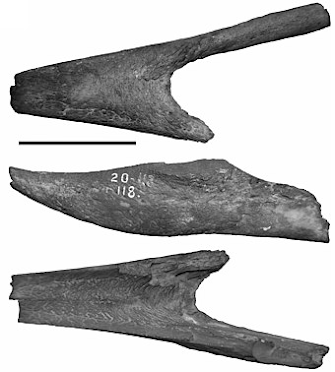Fossil Friday #4 - Phorusracids (Terror Bird)
66 million years ago, the K-Pg extinction event saw the end of the (non-avian) dinosaurs. This marked the beginning of the reign of mammals on earth, as they were able to diversify and evolve to fill almost all niches that were previously unattainable during the Mesozoic era. As with any trend in evolutionary biology, there are always outliers. Up until ∼100,000 years ago, South America was ruled by a group of theropods, the Phorusrhacids, also known as the Terror Birds.
A diverse group of birds, 18 species have been discovered so far, mostly in South America, an area that produced some of the Cenozoic's most astonishing animals, due to its isolation from the rest of the world up until the land bridge between North and South America was formed ∼2.6ma (AZ Animals, 2020). The type specimen, belonging to Phorusracos longissimus, is of a fragmented mandible, equalling 60cm in length, and was discovered by Florentino Ameghino at the Santa Cruz formation, Patagonia in 1887. At first, it was questioned as to what type of animal the mandible belonged to, and it wasn't until 1891, after more discoveries, that it was thought to have belonged to a very large bird (Alvarenga and Höfling, 2003).


Titanis walleri skeleton (Florida Museum of Artists reconstruction of Titanis walleri, based on Natural History, 2020). features from large modern birds.
Alvarenga, H.M.F. and Höfling, E. (2003) “Systematic revision of the Phorusrhacidae (aves: Ralliformes),” Papéis Avulsos de Zoologia (São Paulo), 43(4). Available at: https://doi.org/10.1590/s0031-10492003000400001.
Baskin, J.A. (1995) “The giant flightless bird Titanis walleri (aves: Phorusrhacidae) from the Pleistocene Coastal Plain of South Texas,” Journal of Vertebrate Paleontology, 15(4), pp. 842–844. Available at: https://doi.org/10.1080/02724634.1995.10011266.
Brodkorb, P. (1963) “A giant flightless bird from the pleistocene of Florida,” The Auk, 80(2), pp. 111–115. Available at: https://doi.org/10.2307/4082556.
Gelfo, J.N. and Plata, M. (2016). “Horned Armadillos and rafting monkeys. the fascinating fossil mammals of south America". Cloth 320 pages, 197 color illus. series: Life of the past, Indiana University Press. ISBN: 978-0-253-02084-0,” Ameghiniana, 53(6), pp. 705–706. Available at: https://doi.org/10.5710/amgh.v53i6.1.
Phorusrhacos (2022) AZ Animals. Available at: https://a-z-animals.com/animals/phorusrhacos/#single-animal-text (Accessed: January 19, 2023).
Woodburne, M.O. (2010) “The Great American Biotic Interchange: Dispersals, tectonics, climate, sea level and holding pens,” Journal of Mammalian Evolution, 17(4), pp. 245–264. Available at: https://doi.org/10.1007/s10914-010-9144-8.


Comments
Post a Comment